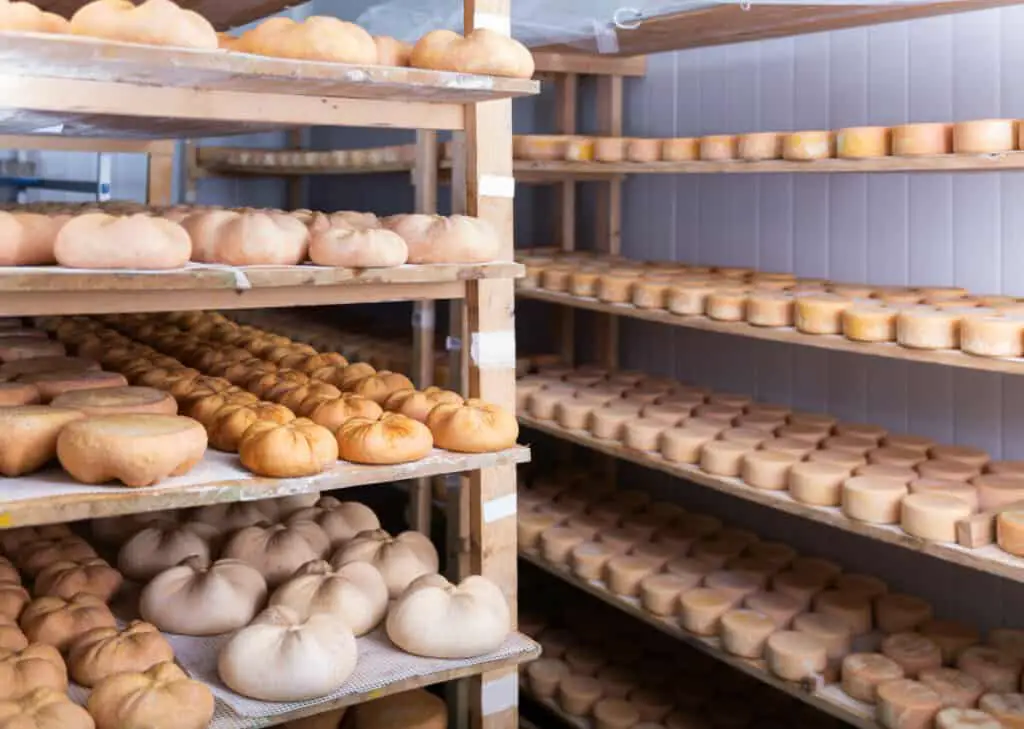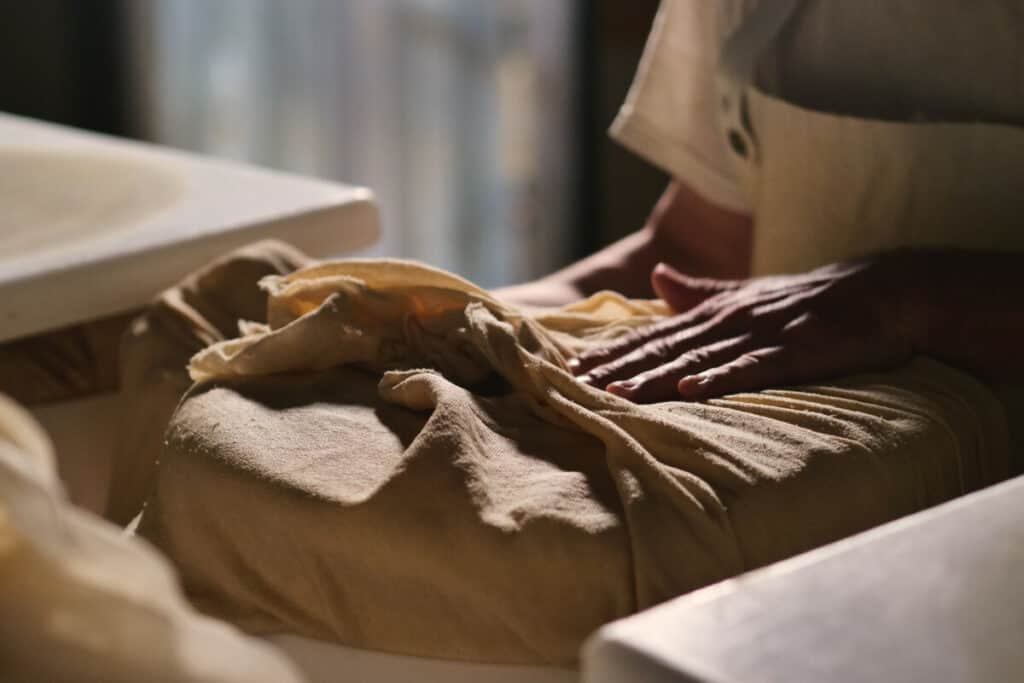This post contains affiliate links.
Cheese is a popular cooking ingredient, snack, and gift for gourmets. With so many varieties to choose from, there is something for everyone to love! What happens if it is tragically left out overnight?
Most cheese is not safe to eat after being left out overnight, since it is already cut and exposed to bacteria. Certain hard cheeses with low moisture content, high acidity, and correct preservation techniques, can be stored outside the fridge. Parmesean wheels are an example of this.

There is still variety in how long cut cheese can last on a counter, and even what cheeses would benefit from some time outside the fridge. Aesthetics can help you determine safety! For more information on how to avoid food poisoning from your favorite food, keep reading below.
What Cheese is Safe to Eat After Being Left Out Overnight?
The only cheese that is completely safe to eat after being left out overnight is shelf-stable or preserved cheese. Cheddar or aged gouda preserved in wax, wheels of parmesan cheese, pecorino romano, and shelf-stable cheeses can all be stored in a cool and dark location on your shelves to age. In fact, it is nearly impossible to cut through a big wheel of parmesan cheese unless it has been left out at room temperature for at least 12 hours!
Even cheeses like Brie and Camembert can be left out for a night under the right conditions. If the kitchen is not too warm, the rind is totally intact, and it will be eaten quickly the next day, these cheeses can spend a night out of the fridge to finish aging and develop their signature gooey interior. This should not be attempted by someone who does not know what these cheeses are supposed to taste like.
How Long can Cheese be Left Out of the Fridge?
The great thing about most cheese is that it will actually tell you when it needs to be tossed out . Have you ever seen a forgotten deli tray at a party and noticed that the sliced cheddar looks oily, shriveled, and hard? Did you think it looked pretty unappetizing? That’s your sign! Harder cheese releases oil and moisture when it’s been out for too long, and this happens right around the point that you needed to dispose of it.
. Have you ever seen a forgotten deli tray at a party and noticed that the sliced cheddar looks oily, shriveled, and hard? Did you think it looked pretty unappetizing? That’s your sign! Harder cheese releases oil and moisture when it’s been out for too long, and this happens right around the point that you needed to dispose of it.
The exact timeline of when you need to dispose of cheese is a little more sensitive. In general, it’s safe to assume that your cheese board or party tray should be consumed or cleaned up within 2-4 hours, depending on what you used. Besides being safer, this will keep the table looking appetizing.
If you think you’ll need food on the table longer, try making two smaller boards that you can switch out. This will save you from food poisoning and the dreaded weepy cheddar.
Common Cheeses and Their Countertop Lifespan

Sliced Deli Cheeses
Sliced deli cheeses like swiss, cheddar, smoked gouda, havarti, or muenster can stay out of the fridge for a comfortable two hours on a sandwich tray before being returned to the fridge. Their low moisture content and higher acidity make it harder for bacteria to grow. Four hours is probably as far as you can safely push it, and by then the cheese won’t look appetizing anyways.
like swiss, cheddar, smoked gouda, havarti, or muenster can stay out of the fridge for a comfortable two hours on a sandwich tray before being returned to the fridge. Their low moisture content and higher acidity make it harder for bacteria to grow. Four hours is probably as far as you can safely push it, and by then the cheese won’t look appetizing anyways.
Pre-Grated Cheese
Pizza mix, fiesta mix, shredded cheddar, and all the other convenient variations are a staple in fridges across the US. Who hasn’t found a bag on the counter the morning after a late-night snack? Yes, it’s sketchy, but surely all those preservatives will protect you from spoilage, right?
It turns out that you shouldn’t risk eating that cheese. Pre-grated cheese has lots of surface area for bacteria to grow on, and it starts to get sticky and gluey shortly after reaching room temperature. Stick to the same four-hour rule as you would with sliced cheese, then toss it.
If it smells weird, is slimy, or just gives you a bad feeling, trust your gut and let it go earlier. If you really insist on eating it, cook it thoroughly.
Cream Cheese
Do not eat this if it has been out for more than two hours. Just don’t do it. Cream cheese has a high moisture content, low acidity, and is often eaten without cooking, so bacteria can penetrate to the center and cause spoilage. Don’t eat moldy cream cheese, either. You don’t want to risk food poisoning for a bagel.
Blocks of Cheddar, Swiss, or Pepper Jack
Sealed blocks of cheese offer an easy way to tell if they’ve gone bad. If the sealed plastic wrap is puffy, don’t eat it.
This is because that ballooning is caused by bacteria. Rot and spoilage give off gas, which causes the plastic wrap to inflate. Don’t buy cheese that has a puffy package, and don’t eat cheese in your fridge with a puffy package.
If your brick of cheese is already opened, it will go ugly before it will spoil. You can leave the brick out for 4-8 hours , depending on the temperature in your kitchen, as well as other factors like the type of cheese and how aged it is, but it can go through the same process as sliced cheese and end up “oily.”
, depending on the temperature in your kitchen, as well as other factors like the type of cheese and how aged it is, but it can go through the same process as sliced cheese and end up “oily.”
If it’s ugly but still in the safe zone for time, cut off the dried areas and use the rest for cooking. That will give you some security.
Mozzarella
Mozzarella is one of the trickiest cheeses to preserve well. Fresh mozzarella is soft at the center and has a very high moisture content, leaving it vulnerable to rapid bacterial growth. Block mozzarella, however, has low moisture content and a counter life more similar to other brick cheeses.
Fresh mozzarella, brined mozzarella, or any other high moisture content mozzarella should not be left on the counter for more than two hours. This includes those adorable little mozzarella balls used for Caprese salads or appetizers. Unless you are a professional cheesemonger, don’t mess with this rule.
Other types of mozzarella with lower moisture should still be refrigerated before the four-hour mark. Nobody likes dried-out mozzarella, and it isn’t worth risking food poisoning.
Parmesean Shakers
If it isn’t opened, you can keep your shaker of parmesan in the cupboard or on the counter until the expiration date. Once it’s opened, however, you should refrigerate it when it isn’t in use. Even restaurants that leave the parmesan out all day will refrigerate it overnight to inhibit mold growth and extend the shelf life. This is a case of bare fact, where leaving it out overnight won’t kill you, versus functional safety where you should try to make sure it stays in the fridge.
American Cheese
This is a topic of hot debate. Velveeta cheese that is unopened does not need refrigeration and isn’t even sold in the refrigerated section of most stores. The USDA website even says that American cheese doesn’t technically need refrigeration. However, enough people have eaten questionable cheese that it is recommended to store this in the fridge anyways.
even says that American cheese doesn’t technically need refrigeration. However, enough people have eaten questionable cheese that it is recommended to store this in the fridge anyways.
If you leave it out overnight, you might be fine. Smell it, check it for mold, and try cooking it before you eat it.
Babybel Cheese
Even though Babybel cheese is wrapped in wax, it should not be left outside of the fridge for more than two to four hours. Any longer than this is risking the cheese spoiling. This recommendation comes straight from the manufacturers .
.
If Cheese is Made By Aging, Why Can’t I Leave it Out?

The short answer here is that you are not a professional cheesemaker. You don’t have the training necessary to determine if conditions are safe, if the cheese is still good, and if you’re risking a stomach ache or death.
The long answer is a little more scientific. Basically, cheese making isn’t as simple as sticking a pressed block of cheese curds in a cave and hoping things work out.
Temperature
Cheese caves are very cool . They maintain a temperature of between 45 and 60 degrees, depending on the location and the cheese, and it needs to be regulated. Unless your home is consistently this chilly, humidity controlled, and is optimized to protect the exact bacteria and molds you want on your cheese, you cannot leave any cheese on the counter with confidence.
. They maintain a temperature of between 45 and 60 degrees, depending on the location and the cheese, and it needs to be regulated. Unless your home is consistently this chilly, humidity controlled, and is optimized to protect the exact bacteria and molds you want on your cheese, you cannot leave any cheese on the counter with confidence.
Mold/Bacteria
There are good molds, and there are bad molds. The white mold that grows around brie cheese is safe and pleasant to eat, and it gives brie the signature flavor that cheese-lovers crave. The blue mold in gorgonzola or Roquefort cheese is similar, if more aggressive. You can’t have those cheeses without the special mold.
The white mold that grows around brie cheese is safe and pleasant to eat, and it gives brie the signature flavor that cheese-lovers crave. The blue mold in gorgonzola or Roquefort cheese is similar, if more aggressive. You can’t have those cheeses without the special mold.
However, the mold growing on your block of cheddar cheese is not your friend. You need to cut that and all surrounding surfaces off the block of cheese before it can be safe to eat. If you find mold on a soft cheese like cream cheese, marscapone, or ricotta, you need to throw the entire thing away. Bad mold can literally kill you.
is not your friend. You need to cut that and all surrounding surfaces off the block of cheese before it can be safe to eat. If you find mold on a soft cheese like cream cheese, marscapone, or ricotta, you need to throw the entire thing away. Bad mold can literally kill you.
The same is true of bacteria. While some bacteria is encouraged in the cheese ripening process, other bacterias are dangerous and cause food poisoning. Your kitchen is not a controlled environment where you can decide which one is going to grow on your cheese.
Protective Rinds, Waxes, and Cases
Cheese aged in a cave has some sort of protective coating. That coating could be edible mold, wax, a box, or a hard rind carefully developed by the aging process. Whatever it is, it is vital to the safe and controlled ripening of the cheese. This coating is part of what allows the cheese to stay on the shelves and ripen for so long.
Whatever it is, it is vital to the safe and controlled ripening of the cheese. This coating is part of what allows the cheese to stay on the shelves and ripen for so long.
Once the cheese is cut, packaged, and sold, it is no longer protected by that coating. Wax doesn’t coat the entire wedge of gouda, parmesan isn’t covered in a thick rind, and the block of cheddar has been exposed to outside bacteria and other factors that can make it spoil.
If you want to keep a hard cheese shelf stable, you need to recreate that protective casing. Some cheeses, like hard cheddar, can be dipped in vinegar and re-waxed at home. If you haven’t done this, don’t count on that casing to keep your cheese safe.
How Does Cheese Age?
Cheeses all start out with milk, salt, and something to separate the milk into curds and whey. Sometimes this is culture, and sometimes this is an acid like lemon juice or vinegar. Different catalysts produce different cheeses.

Whatever you use, the result is some delicious curds and whey that can be cooked, drained, squeezed out, pressed, or processed in hundreds of ways to make the cheeses you love. These basic ingredients have incredible variety due to the techniques used in preparing them.
Cheese ripening is a vital part of the cheesemaking process. It’s this ripening that gives us true variety in cheeses since the mold and brine used makes the biggest difference between brie and camembert, or cheddar and gouda. Some cheeses, like Roquefort,
is a vital part of the cheesemaking process. It’s this ripening that gives us true variety in cheeses since the mold and brine used makes the biggest difference between brie and camembert, or cheddar and gouda. Some cheeses, like Roquefort, are even named after the location where they were developed because it created the distinctive flavors we love.
are even named after the location where they were developed because it created the distinctive flavors we love.
How Does Ripening Happen?
Ripening starts when good bacteria, culture, or mold is added to the milk or rubbed on the exterior of the cheese block during the process of making cheese. Over the course of the ripening process, this flavors and changes the cheese to give it a unique flavor or appearance. Swiss cheese, for example, gets its signature bubbly look from this process.
Examples of Good Mold Inside the Cheese
Good mold makes flavorful cheeses. Some examples of delicious moldy cheese include the following:
Some examples of delicious moldy cheese include the following:
- Gorgonzola
- Blue
- Roquefort
- Humbolt Fog
- Stilton
Keep in mind that just because this mold is good in one cheese, that does not mean it is good in every cheese. Keep your blue cheeses quarantined if you don’t want the mold to spread to everything else in your refrigerator.
Good Mold Outside the Cheese
These cheeses are usually soft, which leaves them vulnerable to spoilage, but they’re delicious when done right. They include:
- Camembert
- Collumniers
- Brie
- Mountaineer
- Little Lucy Brie
This mold usually doesn’t spread to other cheeses, but it might re-coat sections of the cheese you cut from. If this happens, don’t be alarmed. It’s still safe to eat!


